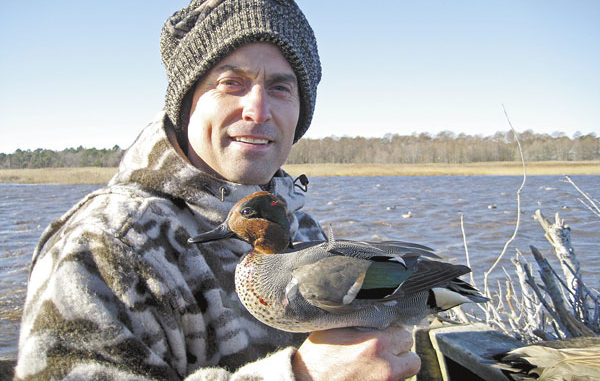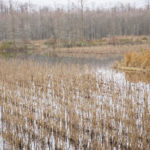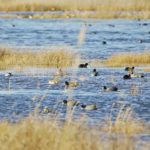
Duck season is closing in for anxious waterfowlers, and after another extremely dry spring and early summer, corn crops continue to suffer. Hopefully for many impoundment owners, conditions failed to decimate corn crops intended for summering ducks 2,000 miles away. Early August continues to allow waterfowlers in the Carolinas adequate opportunity to plant and produce a variety of foods that will be well received by the migrating feathered flock.
Ducks begin to leave their summer breeding grounds as diminishing daylight triggers their journey to the southern states. While the majority of ducks arrive well into the fall and early winter, preparing a full crop of ideal grains is a necessity for many waterfowl enthusiasts, and with good reason. Historically, corn is the crop of choice for drilling in the majority of duck impoundments in the southeast, and August is just too late to start a crop for the 2011-12 season. Ducks do love those sweet, golden kernels, but many other grain and seed crops with shorter maturation periods are well-received by migrating waterfowl.
Ducks prefer small-grained foods that are full of energy and easily-accessible within flooded waters. Luckily, several of these foods can be planted as late as August in the Carolinas, just in time for the arrival of the migrating waterfowl. Japanese millet, brown-top millet, white proso millet, buckwheat, sorghum and even wheat have small, nutrient-rich seeds highly-favored by migrating waterfowl.
These cereal grains have a high raw-protein content between 10 and 20 percent and offer prime nutrition for migrating ducks. While wheat will not mature enough for seed-head development, the tender sprouts will offer ducks a tasty treat loaded with antioxidants and a prime energy source. Buckwheat itself is extremely high in fat, providing ducks with a rich energy source ideal for winter foraging conditions as well.
These cereal grains mature 60 to 90 days after planting. Planted in early August, they will mature sometime in October, just in time to introduce the new crops to 12 to 24 inches of water. Japanese millet is tolerant of shallow flooding; therefore, it can be partially-flooded prior to complete maturation. While a few early flocks of green-wing and blue-wing teal arrive in September, the first substantial wave of migrating ducks will not arrive until November — depending on adverse weather.
However, maturation dates on these crops is not the concern when planted at the end of the season. Killer frosts and cold conditions will halt growth and prevent full seed development and maturation. Early August should be the last interval for planting the majority of these crops. In areas in the Carolinas where significant frosts occur as early as October, brown-top and white proso millet should be planted; they mature in 60 to 70 days.
Provide legal runways for best hunting results
Duck hunters across the country use a variety of methods to entice ducks into shotgun range. Depending on the layout of the hunt, the use of decoys has little effect on the success of an excursion when pass-shooting methods are utilized. However, impoundments and other open-water hunts require decoys and a systematic placement scheme to draw ducks into range. Planting impoundments should utilize similar techniques to lure ducks into a specified landing zone.
Decoy spreads vary among hunters and hunting location, but all spreads incorporate holes, “Vs” or some sort of ideal, empty landing area. While ducks want to be around many other ducks, few want to land on top of another bird. They look for open areas within a flock or open water adjacent to food sources.
Duck impoundments are no different. Some flooded crop fields offer ducks with few landing zones. While these birds will usually find a place to land, providing landing zones close to blinds will increase the probability of having these birds land in an ideal location. They also provide ideal areas to place a few decoys that will be easily-noticed from the air.
Landing zones should be between five and 15 feet wide, with a preferred width of 10 feet. “Landing strips” should not be created after crops mature through mowing or discing. Intentionally knocking down or mowing crops to scatter matured seeds in waterfowl impoundments is considered baiting and is illegal. However, crops can be harvested using normal harvesting machinery/practices to create these strips after crops mature. This type of activity is considered a legal method in impoundments where crops are specifically-planted for waterfowl and hunted over during the duck season.
Landing zones are beneficial in impoundments, but they can still provide available foods for ducks as well. While these areas are void of planted seed, they still should be prepared for seed with discing and fertilization to encourage natural grasses to develop. Wheat can also be planted within these landing zones that will provide ducks with nutritional sprouts and a quick deterioration rate allowing the open water areas to develop.
Fertilization will fortify natural impoundments
Waterfowl will eat a wide variety of natural vegetation, including seeds, tubers and tender sprouts. Most impoundments are constructed in low-lying areas with the ability to retain water. Many natural foods preferred by waterfowl will grow in these naturally-moist soil areas without the first seed being planted. Planting commercial cereal grains is not always required to draw ducks into a flooded field in the fall. In fact, many naturally-occurring foods will produce a higher volume of palatable, nutritional material for ducks to devour as they arrive.
While vegetation will vary from different parts of the Carolinas, beggars tick, crabgrass, sedges, smartweed, curly dock and other grasses/forbs often make up a high percentage of the pioneer species in low-lying areas. These natural species contains respectable levels of fat, crude protein, and vitamins providing ducks with the right recipe in high volumes.
Fertilize these natural impoundments with a balanced combination of nitrogen, potassium and phosphorus to boost the production of these natural waterfowl foods in August, while the days are still long. Flooding can occur just before arrival of the first few flocks of migrating waterfowl into the area.
While fields of corn, millet, and sorghum offer ducks a favorable food source, natural vegetation in moist-soil areas can also provide more-than-adequate groceries for migrating waterfowl each winter.








Be the first to comment